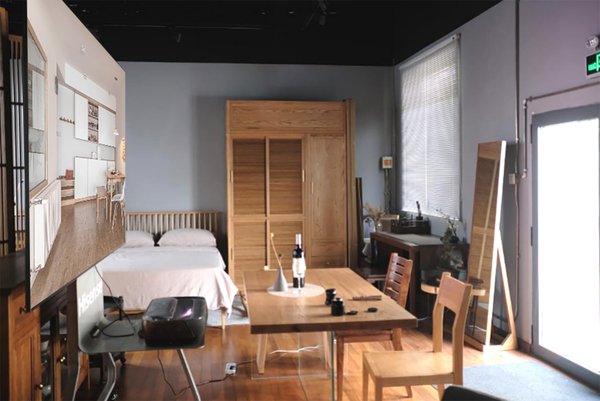Disadvantages of Ultra Short Throw Projectors:
1. Ultra-short-throw projectors offer exceptional features, but it's important to note that they typically don't match the brightness of a traditional LED TV of the same size.
The overall brightness of an ultra-short-throw projector remains relatively lower in comparison.
2. Expensive
When compared to most standard projectors, ultra-short-throw projectors tend to be pricier, with starting prices usually around €1,000 and reaching up to €6,000 for a top-of-the-line model.
3. Ultra-short-throw projectors demand a high level of flatness on the projection surface, whereas long-throw projectors do not necessitate this requirement.
Here, I'm using the AWOL Vision LTV-3500, and you can see that the picture quality is acceptable. However, you may notice that the lines at the edges of the picture are not perfectly straight. This is not a problem with my projector but rather due to the flatness of the white wall.
A long-throw projector directly projected onto a wall may not exhibit this effect, but an ultra-short throw projector will.
So, in most instances, you'll likely require a UST ALR screen.

4. You may also need to pair it with an ALR screen. And an ust alr screen will cost at least 400€.
However, not everyone may require a screen purchase. You can find more details on this topic in the article.
5. If your projector is not bright enough and you aim to project an image larger than 130 inches, you may experience uneven brightness on the screen, resulting in a phenomenon known as diagonal defocus.
This phenomenon can be likened to shining a torch at a wall. Initially, you see a circle with sharp, well-defined edges. However, as you move farther away, the lines around the edges of the circle gradually blur as it enlarges.
6. Ultra-short-throw projectors have limited flexibility in placement.
Their height, distance from the wall, and direction are fixed and difficult to adjust. In contrast, traditional projectors with lens shift functionality offer greater placement flexibility, allowing image could be project from sideways and even upward position.
7. Ultra-short-throw projectors require manual adjustment to align the projector image with your screen.
If you have small cats or dogs at home and your ultra-short-throw projector is placed on the floor or on a stool, it's susceptible to accidental collisions. This may result in the projected image appearing skewed on the wall, requiring manual readjustment by a person.
Despite ust projectors featuring an 8-Point keystone correction feature, utilizing it may compromise picture quality. Therefore, manual adjustments are often still necessary.
8. Noise can be a concern, especially with brighter projectors, as higher brightness often correlates with increased fan noise. This can occasionally detract from the viewing experience.
9. Central channal location. The positioning of the central channel conflicts with the ultra-short-throw projector. Placing it in front of the projector is likely to obstruct the projected light.
10. There is a lack of TV cabinets on the market that are compatible with ultra-short-throw projectors. You may need to customise a cabinet.
Of course this shouldn't be a problem if the home improvement environment is not very high demanding
Who would benefit most from purchasing an ultra-short-throw projector?
1. Limited room space.
Using a long throw projector requires adequate space reservation. If your room features a ceiling chandelier or lacks sufficient roominess, a long throw projector may not be suitable. In contrast, ultra-short-throw projectors are ideal for space-constrained homes, as they can project onto a wall without needing extensive room.
2. Prefer not to have interference
When enjoying a movie, the last thing you want is to have passing people obstructing the projector's light source. Similarly, if you're immersed in a physical game, you can stand up and participate without concern about blocking the light source.
3. People with a need for mobile displays.
Previously, we used to place a large screen at the entrance of the exhibition hall for displays, often requiring frequent relocation. The advantage of using a laser TV is its ability to be both large and lightweight, making it simpler compared to an LCD TV.

We also have laser tv stands designed for easy mobility.

4. If you're considering setting up a home theater but find wiring to be cumbersome
5. For those seeking a cinematic experience on a budget, but are restricted from purchasing a large TV
6. You value home aesthetics and don't want to spoil the beautiful walls of your house, or don't want to have a "black hole" in the wall.
For those who prioritize home aesthetics, the idea of drilling holes into their pristine walls may be unappealing. The combination of an ultra-short-throw projector with a floor rising screen offers an ideal solution to this dilemma.

When not in use, you can retract the screen, ensuring your home décor remains tidy and saving valuable space.
Instances where purchasing an ultra-short-throw projector might not be necessary
1. If you have a spacious basement or room, a standard throw projector may suffice.
Long throw projectors typically come at a lower price point compared to ultra-short throw projectors.
Additionally, a long throw projector can effectively pair with a light-resistant screen. Therefore, if space and wiring are not limiting factors for you, opting for a long throw projector may be a suitable choice.
2. If you're content with a screen size of 90" or smaller, or if you can purchase a TV of similar size for a comparable price, an ultra-short-throw projector may not be necessary for you.
The reason why ultra-short throw projectors are so popular is that they tend to be cheaper than LED TVs of the same size.














